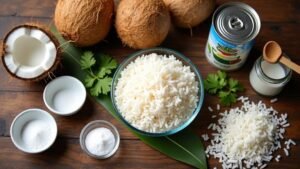Table of Contents
I. Introduction
Choosing the right rice cooker is a crucial decision that can significantly impact your cooking experience. Among the various types available, ceramic rice cookers have been gaining popularity due to their unique features and benefits. This article provides a comprehensive overview of the pros and cons of ceramic rice cookers, helping you make an informed decision.
II. What is a Ceramic Rice Cooker?
A ceramic rice cooker is a type of rice cooker that uses a ceramic pot for cooking. The ceramic pot is non-reactive, meaning it does not react with the food, keeping it healthy and safe. The evolution of ceramic rice cookers can be traced back to traditional cooking methods where ceramic pots were used over a fire.
Today, they have been integrated with modern technology to provide a convenient and efficient cooking experience.
III. Pros of Ceramic Rice Cookers
Ceramic rice cookers offer several advantages:
- Health Benefits: The non-reactive nature of ceramic ensures no harmful chemicals leach into your food.
- Heat Distribution: Ceramic pots provide even and consistent heat distribution, resulting in perfectly cooked rice.
- Taste: Many users report an improved taste of rice cooked in ceramic pots.
- Durability: Ceramic pots are long-lasting and tough, resisting scratches and wear over time.
- Versatility: They are suitable for cooking various types of rice and dishes.
IV. Cons of Ceramic Rice Cookers
Despite their benefits, ceramic rice cookers also have some drawbacks:
- Weight: plays a significant role in its portability. Ceramic pots, while renowned for their superior cooking capabilities, tend to be heavier than other types of pots. This aspect may make them slightly less convenient for those who prioritize mobility and ease of transport in their culinary adventures.
- Price: the price of ceramic pots often reflects the quality and craftsmanship associated with this material. It’s worth noting that ceramic pots generally carry a higher price tag compared to their counterparts due to the cost of the ceramic material itself. However, this elevated price point often pays off in the form of exceptional cooking performance and durability, making ceramic pots a worthwhile investment for passionate home chefs.
- Fragility: While ceramic pots offer numerous benefits, they do come with a certain degree of fragility that requires careful handling. The risk of cracking or chipping is present if the pot is accidentally dropped or mishandled. Therefore, it’s important to exercise caution and be mindful of their delicate nature to ensure their longevity and continued functionality.
- Cooking Time: When it comes to cooking time, ceramic pots may require a tad more patience compared to pots made from other materials. The inherent properties of ceramic contribute to a slower and more gradual heating process, which can extend the cooking time for rice preparations. However, this characteristic can also work to your advantage as it allows for more controlled and even heat distribution, resulting in perfectly cooked rice grains that are worth the wait.
- Maintenance: to maintain the pristine condition of ceramic pots, proper cleaning and handling practices are paramount. This delicate material requires gentle care to prevent damage and preserve its aesthetic appeal. Regular cleaning with mild detergents and avoiding abrasive scrubbing tools will help keep your ceramic pot in top-notch condition, ensuring its longevity and continued performance in your culinary endeavors.
By considering these various aspects, you can make an informed decision about whether a ceramic pot aligns with your specific needs and preferences. While they may have their unique characteristics and considerations, ceramic pots offer exceptional cooking capabilities and the potential for culinary mastery that can elevate your gastronomic experiences to new heights.
V. Ceramic Rice Cookers vs. Other Types
When compared to other types of rice cookers, ceramic ones stand out for their health benefits and heat distribution. However, they may not be the best choice for everyone. For instance, stainless steel rice cookers are lighter and more affordable, while non-stick rice cookers offer easy cleaning and faster cooking times. Aluminum rice cookers, on the other hand, are lightweight and inexpensive but may react with certain foods.
VI. Top Ceramic Rice Cookers in the Market
Several brands and models of ceramic rice cookers have received positive customer reviews. Some of the top-rated ones include the “Panda Mini Rice Cooker” and the “GreenLife Healthy Ceramic Nonstick Rice Cooker”. These models are praised for their quality, performance, and durability. Before making a purchase, it’s recommended to research and compare different models to find the one that best suits your needs and preferences.
- Easy to Clean: We’ve created a special version of our healthy ceramic nonstick coating for kitchen electrics that’s designed for optimal performance when plugged in
Prices pulled from the Amazon Product Advertising API on:
Product prices and availability are accurate as of the date/time indicated and are subject to change. Any price and availability information displayed on [relevant Amazon Site(s), as applicable] at the time of purchase will apply to the purchase of this product.
FAQs
- Is ceramic coating rice cooker safe?
- Yes, ceramic coating in rice cookers is generally safe as it is non-reactive and does not leach harmful chemicals into the food.
- How do you cook rice in a ceramic cooker?
- Cooking rice in a ceramic cooker is similar to other types of rice cookers. You add the rice and water, then set the cooker to the appropriate setting.
- What is the common problem of the rice cooker?
- Common problems with rice cookers can include uneven cooking, the rice sticking to the pot, or the cooker not turning on. The specific problems can vary based on the type and brand of the cooker.
- How do you clean a ceramic rice cooker?
- Ceramic rice cookers should be cleaned carefully to avoid scratching or damaging the ceramic surface. It’s recommended to use a soft sponge and mild detergent, and to avoid using abrasive cleaners or scrub pads.
- Does the ceramic coating wear off over time?
- With normal use, the ceramic coating can wear off over time. When the coating becomes thin, it can be scratched easily. Therefore, it’s important to handle ceramic pots with care to maintain their coating.
Conclusion
In conclusion, ceramic rice cookers offer a unique set of advantages and disadvantages. They are known for their health benefits, even heat distribution, and versatility, but they also have their drawbacks such as weight, cost, and fragility. When compared to other types of rice cookers, they stand out for their unique features, but the choice ultimately depends on your specific needs and preferences.
Are you ready to elevate your cooking experience with a ceramic rice cooker? Do your research, consider the pros and cons, and make an informed decision. Remember, the right rice cooker can make a significant difference in your kitchen. Don’t wait, explore the world of ceramic rice cookers today!







